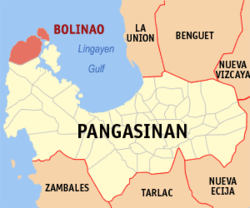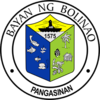Bolinao, Pangasinan
| Bolinao | ||
|---|---|---|
| Municipality | ||
 |
||
|
||
| Motto: Bayan Ko, | ||
 Map of Pangasinan showing the location of Bolinao |
||
| Location within the Philippines | ||
| Coordinates: 16°20′N 119°53′E / 16.333°N 119.883°ECoordinates: 16°20′N 119°53′E / 16.333°N 119.883°E | ||
| Country |
|
|
| Region | Ilocos (Region I) | |
| Province | Pangasinan | |
| District | 1st district of Pangasinan | |
| Founded | 1575 | |
| Barangays | 30 | |
| Government | ||
| • Mayor | Arnold del Fierro Celeste | |
| • Vice Mayor | Alfonso del Fierro Celeste | |
| • Electorate | 39,870 voters (2016 election) | |
| Area | ||
| • Total | 197.22 km2 (76.15 sq mi) | |
| Population (2015 census) | ||
| • Total | 82,084 | |
| • Density | 420/km2 (1,100/sq mi) | |
| Time zone | PST (UTC+8) | |
| ZIP code | 2406 | |
| 015514000 | ||
| Dialing code | +63 (0)75 | |
| Income class | 1st municipal income class | |
| Revenue | ₱ 23,650,054.19 (2016) | |
| Poverty incidence | 12.47 (2012) | |
Bolinao is a 1st class municipality in the province of Pangasinan, Philippines. According to the 2015 census, it has a population of 82,084 people.
Sea urchins are regularly harvested at Isla Silaki, Bolinao.
Bolinao is politically subdivided into 30 barangays.
Folk etymology attributes the name "Bolinao" or this remote fishing enclave from the fish piece "monamon" but commonly called "Bolinao" by the Tagalogs, Bicolanos and the Visayans. A theory also points out that once upon a time "pamulinawen" trees grew luxuriantly along its shores, thus, the Ilocano migrants who crossed the Lingayen Gulf named it phonetically similar to the name of the tree. Nowadays, however, such tree does not exist anymore.
Unofficial records narrate the story of an Italian missionary named Blessed Odorico who said the first mass in Bolinao Bay, baptizing several locals while he was on his way to China. He took refuge in what is now known as Bolinao during a storm in 1324. Two centuries later, an account narrates the arrival of Juan de Salcedo and his crew reached Bolinao and chanced upon a Chinese Sampan who captured a native chieftain. Salcedo and his men liberated the natives and the latter immediately pledged vassalage to the King of Spain.
According to oral history, the town of Bolinao used to be a small settlement in what is now Barrio Binabalian in Santiago Island, then having a population of just over a hundred families. It is said that Captain Pedro Lombi founded the town of Bolinao in 1575. A decade later, Dominican Friar Esteban Marin became the first Spanish missionary to evangelize the people of Bolinao. For two years he worked in Bolinao before he was assigned as prior in Batac, Ilocos Norte.
The Dominicans ended their service in 1607 to be replaced by the Augustinian Recollects headed by Fr. Jeronimo de Cristo and Dr. Andres del Espiritu Santo. At this time, the old town of Bolinao was still located along the coast of Pangasinan. Due to pirate attacks, the town was transferred to the mainland in 1609.
This town formerly included the neighboring town of Anda, but Anda became an independent municipality on May 26, 1849.
On November 18, 2007, Bolinao challenged the historical fact that the first Mass was held on March 31, 1521, Easter Sunday, at Limasawa in Southern Leyte. Memorial markers (donated by Italian priest Luigi Malamocco, 62, from Odorico's hometown of Friuli, Italy) were set in the town's church and on Santiago Island, claiming that in 1324, Franciscan missionaries led by an Italian priest named Odorico celebrated a thanksgiving Mass thereat and also baptized natives.
...
Wikipedia


